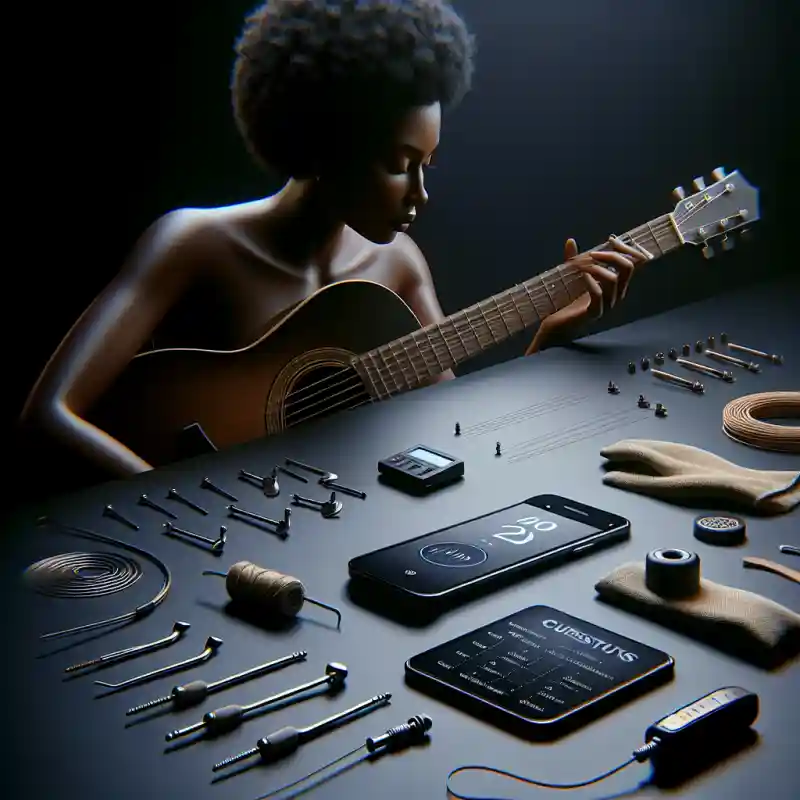From lyric spark to polished demo, writing a song is both an art and a craft. Here you’ll find a concrete, step-by-step approach that covers all core methods for creating original songs of any style, including brainstorming, structuring, lyric writing, melody development, harmonization, arrangements, and final touches. This guide is structured for quick navigation: first, clarifying creative intent; then, moving through lyric and melody generation; building harmonic progressions; crafting arrangements; and finishing with professional polish. Each section focuses on practical techniques and actionable steps, reflecting the latest advice from top songwriters and industry experts.
Structure overview: First, you’ll clarify your song’s purpose and emotional core. Next, you’ll generate ideas and build lyrics and melodies. Then, you’ll develop harmonious progressions and arrange your song for impact. Finally, you’ll refine, edit, and prepare for recording or sharing. Each step is designed to make the process efficient, creative, and personally rewarding.
Define Your Song’s Intent and Emotional Core
Every memorable song begins with a clear purpose or feeling. This sets the direction for your lyrics, melody, and structure. Decide at the outset:
- What emotion or message you want to express. Are you telling a personal story, capturing a mood, or aiming for a universal theme?
- Who your intended audience is. Are you writing for yourself, for a friend, or for a wider audience?
- What genre or style you want to explore. This influences musical choices from tempo to instrumentation.
“A great song starts with a feeling you can’t ignore. If you can name it, you can write it.”
Jot down a single sentence that sums up your intent. For example: “I want to write a bittersweet song about rekindling hope after loss.” This sentence will become your reference point as you create lyrics and melodies.
Idea Generation: Brainstorming Lyrics and Melodic Hooks
Songwriting is a process of discovery. Start by gathering raw material for your lyrics and melodic ideas. Use proven brainstorming strategies to ignite your creativity:
- Freewriting: Set a timer for 10 minutes and write nonstop about your topic. Don’t censor yourself. Capture words, phrases, memories, and sensory details.
- Voice Memo Sketches: Hum or sing any melody fragment that pops into your head. Record it on your phone for later reference.
- Word Association: Write your song’s theme in the center of a page. Branch out with related words, emotions, images, and opposites.
- Lyric Fragments: Collect lines or phrases you overhear, read, or think of during the day. Even a single striking phrase can spark a full song.
- Reference Listening: Listen to songs you admire in your chosen genre. Notice lyric styles, rhyme schemes, and melodic contours.
By the end of this stage, you should have a page of lyric ideas and at least one or two melodic fragments. Don’t worry about quality yet — the goal is to generate material.
Crafting Lyrics: Structure, Rhyme, and Voice
With your raw ideas in hand, shape them into lyrics. The most effective lyrics combine emotional honesty with clear structure and memorable phrasing.
Choosing a Song Structure
Most popular songs use one of a few proven structures. Pick the one that best fits your message and style:
- Verse — Chorus — Verse — Chorus — Bridge — Chorus: The most common pop structure. Verses set the scene, chorus delivers the main message, bridge offers contrast.
- Verse — Verse — Bridge — Verse: Classic folk and singer-songwriter format. No repeated chorus, but often a repeated hook line.
- Verse — Chorus — Verse — Chorus: Simpler structure for shorter or more direct songs.
- ABA or AABA: Standard in jazz and classic pop. “A” section introduces the main theme, “B” offers contrast.
Write a rough outline labeling each section. This blueprint will guide your lyric development and help you keep the song focused.
Writing Verses, Choruses, and Bridges
Each section of your song has a specific function:
- Verses: Tell the story, set the scene, or develop the narrative. Verses often change with each repetition.
- Chorus: The emotional and melodic centerpiece. Repeat the chorus with the same or very similar lyrics each time.
- Bridge: Provides contrast, a new perspective, or a twist. Usually arrives after the second chorus.
Focus each section on a single idea or image. Avoid cramming too much information into one verse. Use active, concrete language and fresh metaphors to bring your message to life.
“The chorus is your anchor. Write it first if you can — it’ll keep you on track.”
Experiment with rhyme schemes that fit your natural voice and style. Popular patterns include ABAB, AABB, and ABCB. Don’t be afraid to break rules if it serves the song’s emotion.
At this stage, you should have a full set of draft lyrics organized into verses, choruses, and (optionally) a bridge. Read them aloud to check for rhythm, word flow, and emotional impact.
Reading your lyrics aloud reveals awkward phrasing, forced rhymes, or places where the emotional flow stalls. Make immediate notes of any lines that feel unnatural or don’t support your song’s central intent.
Developing the Melody: Hooks, Contour, and Rhythm
With your lyrics structured, focus on crafting a melody that supports and enhances your message. Melody is the element listeners recall most readily — it’s where your song’s emotional impact often lives.
- Sing the Lyrics Freely: Try different melodic shapes as you recite your lyrics. Don’t worry about hitting “correct” notes yet; focus on what feels natural.
- Identify the Hook: Find or create a short, memorable melodic phrase — usually in the chorus — that defines your song’s catchiness.
- Experiment with Range: Move between low, conversational verses and higher, more intense choruses. This dynamic contrast adds drama.
- Use Repetition and Variation: Repeat melodic motifs for memorability, but add small changes to maintain interest. A repeated chorus melody with a tiny rhythmic twist can feel fresh every time.
- Consider Syllable Stress: Align strong melodic beats with the natural stress of your words. This gives the melody a conversational, singable feel.
Many songwriters use a piano or guitar to find melodies. Play simple chords and sing your lyrics over them, letting the melody emerge naturally. Record every attempt, even the rough ones — sometimes your first instinct is the strongest.
If you get stuck, try singing your lyrics over the melody of a favorite song (for practice only), then gradually alter the notes until you have something distinct. This jumpstarts your creativity without copying.
Melodic Contour and Emotional Shape
A melody’s “contour” — its rises, falls, and leaps — mirrors the emotional arc of your song. Shape your melody to match the lyrics’ mood in each section:
- Use ascending lines for hope, uplift, or excitement.
- Descending or static lines can convey resignation, calm, or melancholy.
- Jumps (interval leaps) often highlight key emotional words or moments.
“Let your melody tell the story even without words. The notes should feel like the emotion you want to convey.”
Once you have a rough melody for each section, sing through the full song. Notice where the flow breaks or where melodies feel disconnected. Adjust transitions so each section flows smoothly into the next.
Building Harmonic Progressions: Chords and Structure
Harmony gives your melody context and depth. Even simple chord progressions can make a song feel complete and emotionally resonant. Start by mapping basic chords to your melody, then explore substitutions or embellishments for color.
- Choose a Key: Select a key that fits your vocal range and the song’s mood. Most pop and rock songs use major or minor keys, but experimenting with modes (like Dorian or Mixolydian) can add uniqueness.
- Classic Progressions: For accessibility and instant familiarity, try progressions like I–V–vi–IV (C–G–Am–F in C major), I–IV–V–I, or vi–IV–I–V.
- Harmonic Rhythm: Decide how long each chord lasts. Slower changes create space; faster changes add urgency.
- Bridge Progression: Introduce unexpected chords or a key change in your bridge for contrast. This lifts the energy and keeps listeners engaged.
- Use Tension and Release: Resolve dissonant chords or tension notes into stable, consonant chords for emotional payoff.
Play your melody over various chord options. Notice how different harmonies change the song’s feel. Record and compare versions to find what best matches your intent.
Matching Chords to Melody
Check that the chords support the most important melody notes — especially on strong beats. If a key lyric falls on a note outside your chord, try substituting a chord that includes that note. This technique, called “harmonizing to the melody,” gives your song a polished and intentional sound.
At this stage, your song should have a complete lyric, a vocal melody, and a supporting chord progression for each section. You now have the skeleton of a finished song.
Arranging Your Song: Instrumentation and Dynamics
Arrangement is where your song’s personality emerges. This step transforms a simple demo into a piece that feels ready for an audience. Consider how instruments, dynamics, and texture can serve your lyrics and melody.
- Choose Core Instruments: Decide on the primary instruments: acoustic guitar, piano, full band, electronic sounds, or something more experimental? Let the genre and mood guide you.
- Start Simple: Begin with minimal instrumentation. Add layers only where they reinforce the song’s emotional arc.
- Dynamic Contrast: Vary the intensity between sections. For example, keep verses sparse and intimate, then build to a fuller sound in the chorus.
- Use Rests and Space: Silence, short breaks, and instrumental gaps give listeners room to absorb key moments.
- Add Hooks and Motifs: Instrumental hooks — short, repeated riffs or licks — can make your song instantly recognizable.
Don’t be afraid to rearrange sections or try different instrument combinations. Some songs shine with a single voice and guitar; others come alive with layered harmonies, percussion, or even strings and horns.
“A great arrangement highlights your song’s strengths and hides its weaknesses. Less is almost always more.”
Record a rough demo of your arrangement, even if it’s just a voice memo. Listen with fresh ears after a day or two. Notice which parts feel strong and which could be trimmed or changed.
Notice where the arrangement supports your song’s message and where it might distract. Adjust the dynamics, instrumentation, and transitions until every section feels purposeful and emotionally clear.
Editing and Refinement: Polishing Lyrics, Melody, and Structure
With a working arrangement and demo, shift your focus to editing. This stage separates professional songs from rough ideas. Editing is as much about subtraction as addition — removing anything that weakens the impact or distracts from your core message.
- Revisit Your Song’s Intent: Compare every lyric, melody, and chord choice to your original intent sentence. If any element doesn’t serve the main emotion or story, rewrite or cut it.
- Check for Redundancy: Remove repeated ideas or phrases unless they are intentional for effect, especially in verses.
- Smooth Transitions: Ensure each section flows naturally into the next. Awkward jumps in melody, chords, or arrangement can break the listener’s immersion.
- Refine Word Choice: Swap generic words for specific, vivid imagery. Replace clichés with original images or metaphors.
- Edit for Singability: Sing the lyrics out loud and notice any spots where the phrasing feels forced or awkward. Adjust syllables and stresses as needed.
- Test Rhyme and Rhythm: Make sure your rhyme schemes are consistent but not predictable. Vary line lengths and rhythms to keep the song engaging.
Professional songwriters often go through multiple drafts. Don’t hesitate to write several versions of a verse, chorus, or bridge before settling on the strongest one. Trust your instinct, but also step away and return to your song with fresh ears for final tweaks.
“The difference between a good song and a great one is in the details. Edit ruthlessly until every word and note belongs.”
Feedback and Collaboration: Enriching Your Song
Getting outside input is a powerful way to catch weaknesses and elevate your song. Even the best writers benefit from collaboration or honest feedback.
- Play for Trusted Listeners: Share your demo with friends, musicians, or mentors who are willing to give constructive criticism. Ask them what stands out, what confuses them, and which parts they remember.
- Join Songwriting Circles: Many cities and online communities host feedback sessions. Present your song and listen to others’ work for new insights.
- Consider Co-writing: Collaborating with another songwriter can spark fresh ideas, challenge your habits, and fill in gaps in your own skill set.
Take notes on feedback, but filter opinions through your own artistic intent. Not every suggestion will fit your vision, but recurring comments often point to genuine issues.
Final Touches: Demo Recording and Preparing for Release
When your song feels finished, capture a polished demo. Even if you don’t have access to a professional studio, modern technology offers plenty of options for high-quality home recording.
- Choose Your Gear: Use a digital audio workstation (DAW) such as GarageBand, Logic Pro, Ableton Live, or free alternatives like Audacity. Invest in a decent microphone if possible. For simple demos, even a smartphone with a quality app can suffice.
- Record Each Track: Start with a guide vocal and main instrument. Add layers one at a time: harmonies, percussion, bass, and additional instruments. Keep each part clear and purposeful.
- Edit and Mix: Balance volume levels, pan instruments for width, and use reverb or delay for space. Avoid overproduction — clarity is key for a demo.
- Listen on Multiple Devices: Play your demo on headphones, speakers, and in the car. This helps catch issues that might not be obvious in your main setup.
Your demo doesn’t need to be perfect, but it should present your song’s core strengths: lyrics, melody, and emotional atmosphere. This version is suitable for feedback, pitching to artists or producers, or releasing to your audience if you’re an independent artist.
Overcoming Writer’s Block and Staying Productive
Writer’s block is common, even for seasoned songwriters. The most reliable way to break through is to establish routines and embrace imperfection during the early stages of writing. Here are strategies that top songwriters use to keep ideas flowing:
- Write Regularly: Set aside specific times each week to write, even if you don’t feel inspired. Quantity leads to quality over time.
- Change Your Environment: Write in a different room, outside, or at a favorite café. New surroundings can spark creativity.
- Impose Constraints: Limit yourself to three chords, a specific theme, or only using images from nature. Constraints force creative solutions.
- Start with Other Songs: Rewrite a favorite song’s lyrics with your own story, or create a new melody for familiar words. These exercises loosen creative muscles.
- Embrace Bad Ideas: Allow yourself to write “bad” songs without judgment. Often, hidden gems appear in the process of discarding weaker material.
Remember, the aim is progress, not perfection. Each finished song — even if never released — builds your skills and confidence for the next one.
As your songwriting evolves, you’ll notice patterns in your strengths and areas for growth. Document your process, note what techniques consistently work for you, and adjust your approach as needed. Over time, your unique style and workflow will emerge, making each new song easier and more authentic.
Songwriting Tools and Resources for Continued Growth
To sustain creativity and improve your craft, take advantage of tools and resources that professional songwriters use. These can streamline your workflow, spark fresh ideas, and help you connect with a broader songwriting community.
- Lyric Writing Apps: Tools like MasterWriter, Lyric Notepad, or even simple note-taking apps let you organize drafts, rhyme ideas, and snippets on the go.
- Rhyming Dictionaries and Thesauruses: Online resources help you find unique word pairings and expand your lyrical vocabulary quickly.
- Chord Progression Generators: Apps and websites can suggest progressions, inversions, or substitutions for variety in your harmony.
- Recording and Production Software: Explore DAWs beyond the basics as your skills grow. Many platforms offer free trials so you can experiment before investing.
- Songwriting Books and Podcasts: Read and listen to interviews with successful writers. Their stories and techniques can offer fresh strategies and motivation.
- Community Platforms: Sites like SoundCloud, BandLab, or dedicated songwriter forums let you share demos, receive feedback, and find collaborators worldwide.
Regularly exploring new tools not only keeps your process efficient but also exposes you to new musical trends and industry standards. Don’t feel pressured to master every tool at once — adopt what feels natural and helpful for your workflow.
Preparing Songs for Performance and Publication
Once a song is polished and demoed, consider how you’ll bring it to a wider audience. Whether you perform live, pitch to other artists, or publish online, each path has its own best practices.
- Live Performance: Practice your song with emphasis on clarity and emotion. Arrange it for solo performance or with a group, and adapt your arrangement to suit the venue and audience.
- Pitching to Artists or Publishers: Prepare a clean demo and a lyric sheet. Research potential recipients, tailor your pitch, and follow submission guidelines carefully.
- Self-Publishing: Use digital distributors to release your song on streaming platforms. Register your work with a performing rights organization to protect your rights and collect royalties.
- Visual Content: Consider lyric videos or simple performance videos to engage listeners online. Visuals can make your song more shareable and memorable.
Whatever route you choose, ensure your song’s message comes through clearly. Consistent practice, careful preparation, and attention to feedback can turn a finished song into a lasting favorite for listeners.
Conclusion
Writing a song that truly connects is a process of intention, experimentation, and refinement. Begin with a clear emotional or narrative purpose, generate and organize ideas, and shape those ideas into lyrics and melodies that resonate. Build supportive harmonies and arrangements that enhance your message, then polish every detail through editing and feedback. Make use of modern tools and communities to keep your creativity flowing and your skills sharp. Whether you write for yourself or a global audience, the essential steps remain: listen deeply, write honestly, and persist until each song feels inevitable. Every finished work is both a milestone and a stepping stone—an authentic reflection of your unique voice as a songwriter.






